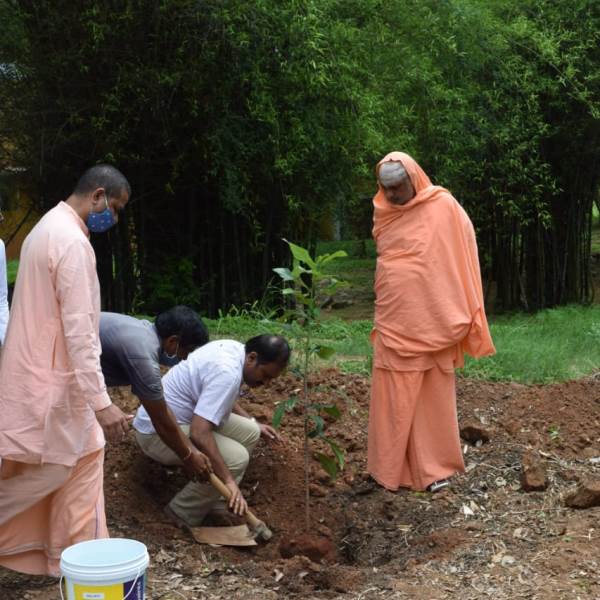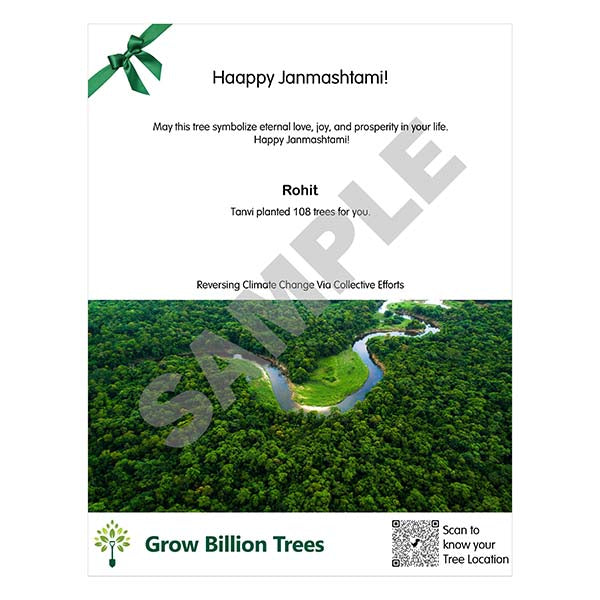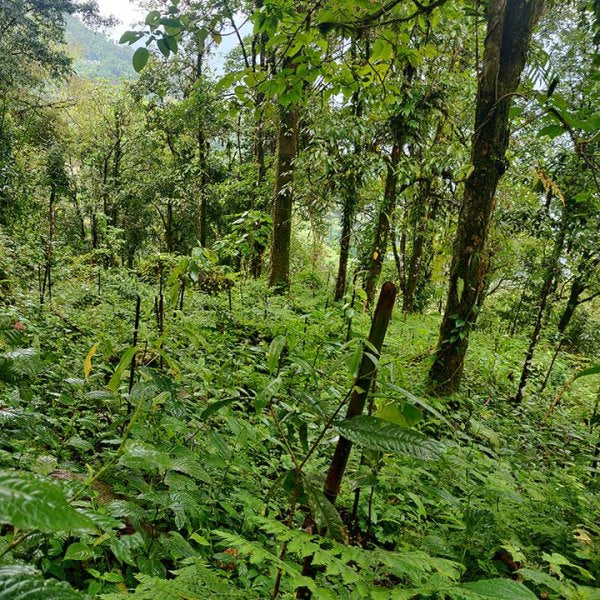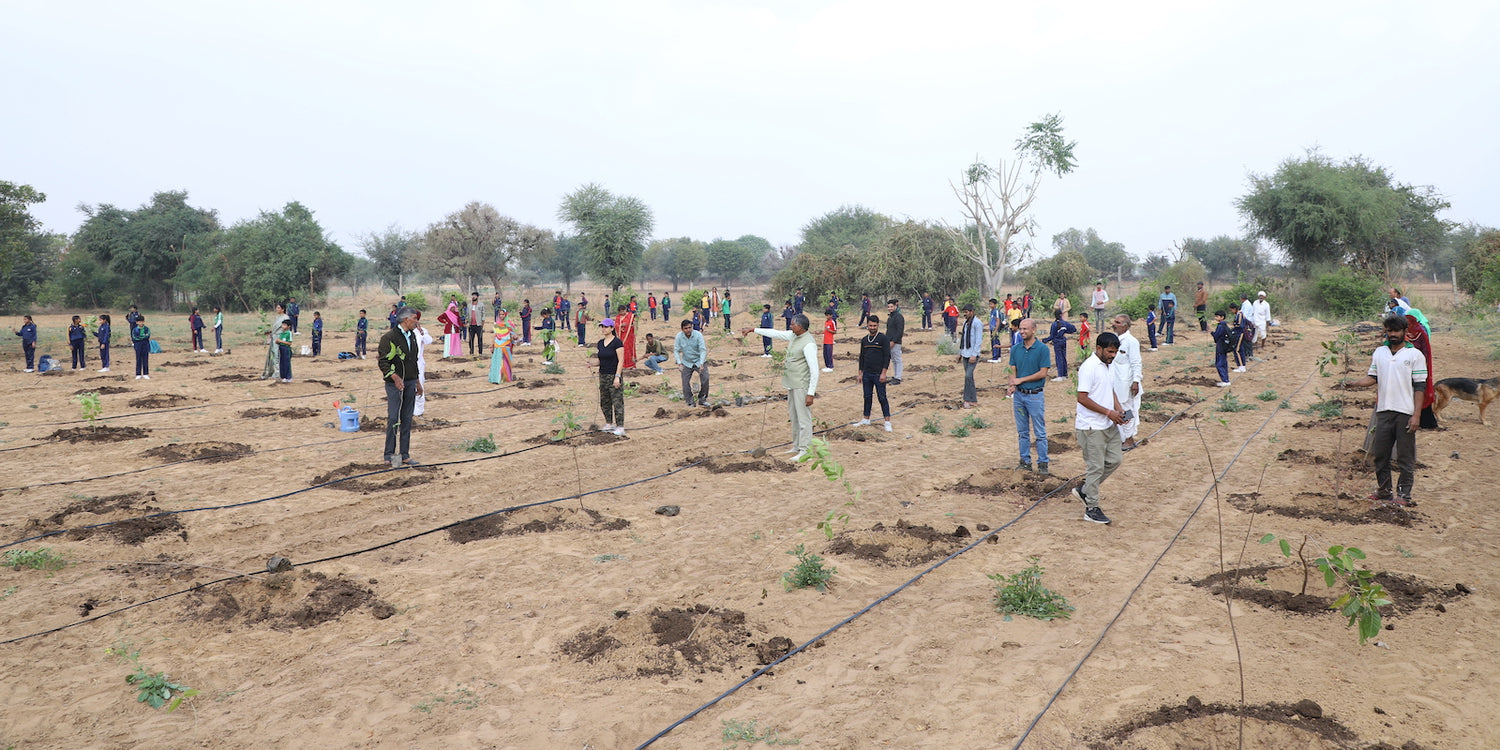Trees for Krishna on Janmashtami
Trees for Krishna on Janmashtami
🌳 2-3ft Tree + 3 Years Nurturing + Geo-Tagged
💡 Tip: 8 Trees for the 8th avatar of Vishnu
108 Trees for 108 names of Krishna
Couldn't load pickup availability
What you get ?
Tree(s) Plantation
Tree(s) Plantation
A tree(s) native to the region will be planted within 7 -10 days, and post-plantation monitoring will be thoroughly managed.
*You will receive an email/whatsapp notification immediately after the tree(s) plantation. or you can check the current status by logging into "My Account" anytime.
e-Greeting Card of Tree(s) Plantation for Gifting
e-Greeting Card of Tree(s) Plantation for Gifting
If you want to gift these tree(s) to your loved ones, You can generate an e-Greeting card for tree(s) plantation by logging into "My Account" after placing order.
*Please generate it within 5 days of placing the order.
e-Certificate of Tree(s) Plantation
e-Certificate of Tree(s) Plantation
A e-certificate of Tree(s) Plantation with the project details will be issued in your name after tree(s) plantation.
*You can download it from "My Account".
Geotag of your Tree(s)
Geotag of your Tree(s)
You can immediately track the live location of the project chosen for your tree(s) plantation, by logging into "My Account" or, by scanning the QR code on the certificate.
*You can see Your Name in respective Project/Forest.
If you want to gift these tree(s) to your loved ones, You can generate an e-Greeting card for tree(s) plantation by logging into "My Account" after placing order.
View full details




Planting trees on Janmashtami is a meaningful way to celebrate the festival while promoting environmental conservation. Trees symbolize l Read more
Trending
Janmashtami Tree Plantation: Celebrate Lord Krishna's Birth
Description:
Planting trees on Janmashtami is a meaningful way to celebrate the festival while promoting environmental conservation. Trees symbolize life, growth, and sustainability, reflecting the essence of Janmashtami.
By planting trees, we honor Lord Krishna's connection with nature and contribute to a greener future. Trees provide us with oxygen, purify the air, conserve water, and support biodiversity. It is a step towards mitigating climate change and preserving the planet for future generations.
Planting trees on Janmashtami embodies reverence for nature and serves as a reminder of our responsibility to protect and nurture the Earth.
Scope:
- Enhancement of Biodiversity
- Increase in Green Cover
- Reduction of Man-Animal Conflict
- Generation of Rural Employment
- Improvement of Wildlife Habitats
Tree Species:
The species of trees that are planted depend on the project, and they are chosen based on their native habitat in the corresponding ecological zone.
Why trees?
Certainly! Here are five key points explaining why planting trees on Janmashtami is important:
- Honoring Lord Krishna: Janmashtami is the birth anniversary of Lord Krishna, who is associated with nature and its preservation. Planting trees on this auspicious day is a way to pay homage to Lord Krishna and his deep connection with the environment.
- Environmental Conservation: Trees play a vital role in maintaining a healthy ecosystem. By planting trees on Janmashtami, we contribute to environmental conservation efforts, such as reducing air pollution, mitigating climate change, and preserving biodiversity.
- Air Purification: Trees absorb carbon dioxide and release oxygen through photosynthesis. By planting trees, we improve air quality, purify the atmosphere, and create a cleaner and healthier environment for all living beings.
- Water Conservation: Trees play a crucial role in water conservation. Their roots help prevent soil erosion and improve water infiltration, reducing the risks of floods and protecting water resources. Planting trees on Janmashtami supports sustainable water management practices.
- Future Sustainability: Planting trees on Janmashtami is an investment in the future. Trees take time to grow, but once mature, they provide numerous benefits, including shade, habitat for wildlife, and improved quality of life for future generations. By planting trees now, we contribute to a sustainable and greener future.
In summary, planting trees on Janmashtami allows us to honor Lord Krishna, contribute to environmental conservation, improve air and water quality, and ensure a sustainable future. It is a meaningful and impactful way to celebrate the festival while making a positive difference to the environment and society
Social Impact:
Planting trees on Janmashtami not only has environmental benefits but also creates a significant social impact. Here are some key points highlighting the social impact of planting trees on Janmashtami:
- Community Engagement: Tree planting on Janmashtami brings communities together. It provides an opportunity for people to unite and work towards a common goal of environmental conservation. By involving the community in tree planting initiatives, social bonds are strengthened, and a sense of collective responsibility is fostered.
- Education and Awareness: Planting trees on Janmashtami can be a platform for raising awareness about the importance of environmental conservation. It offers an opportunity to educate individuals, especially the younger generation, about the value of trees, the need to protect nature, and the impact of human actions on the environment. This promotes environmental consciousness and empowers individuals to take action.
- Health and Well-being: Trees have a positive impact on human health and well-being. By planting trees, we create green spaces that provide shade, improve air quality, and reduce urban heat islands. Access to green areas encourages physical activity, relaxation, and overall well-being, contributing to healthier communities.
- Economic Opportunities: Tree planting initiatives on Janmashtami can lead to economic opportunities for local communities. As trees grow, they create employment opportunities in areas such as forestry, landscaping, and tree care services. Sustainable practices like agroforestry and fruit tree planting can also provide economic benefits through the production of food, timber, or medicinal plants.
- Sense of Pride and Ownership: Planting trees instills a sense of pride and ownership within communities. Individuals who actively participate in tree planting feel a connection to the planted trees and take responsibility for their care and growth. This sense of ownership fosters a sense of pride in the community's environmental efforts and motivates further engagement in environmental initiatives.
- Climate Resilience: Planting trees helps build climate-resilient communities. Trees act as natural carbon sinks, mitigating the impacts of climate change. By creating green spaces and increasing the tree canopy, communities can adapt to changing climate conditions, reduce the risk of natural disasters, and enhance overall resilience.
In conclusion, planting trees on Janmashtami brings communities together, raises environmental awareness, improves health and well-being, creates economic opportunities, fosters a sense of pride and ownership, and contributes to climate resilience. It has a profound social impact, inspiring individuals and communities to actively participate in environmental conservation efforts and work towards a sustainable and prosperous future.
Krishna Janmashtami Tree Plantation
Celebrate Lord Krishna's birth by planting trees on Janmashtami. It's a spiritual way to honor His love for nature and promote environmental sustainability.
Kadamba Trees and Krishna
Learn about the significance of Kadamba trees in Lord Krishna's life and how planting them on Janmashtami connects us to His divine presence.
Devotional Tree Planting
Explore how tree plantation during Janmashtami is not just an environmental gesture but a sacred act of devotion that reflects Krishna's teachings.
Fragrant Parijat Trees
Discover the symbolism of the Parijat tree's fragrant flowers in Lord Krishna's stories and how planting them on Janmashtami can evoke divine love.
Janmashtami Green Celebrations
Find out how planting trees during Janmashtami is a growing tradition that aligns with Lord Krishna's love for nature and His message of sustainable living.
Most Popular
Impact of your Tree
-
Releases Oxygen
A mature tree produces around 120 kilograms of oxygen per year, which is sufficient for one human per year.
-
Reduces Air Pollution
A tree absorbs harmful gases like CO2, NO2 released by factories and vehicles, which can have serious health problems for us
-
Removes CO2
A Tree removes 22 KGs of CO2 from atmosphere per year, which is equivalent to the CO2 realeased by a human in 10 days.
-
Cooling Effect
A Tree generates cooling effect of around 10 room size ACs by providing shade and through a process of transpiration.
Special Plantations
FAQ
What is the significance of Krishna Janmashtami?
: Krishna Janmashtami celebrates the birth of Lord Krishna, an incarnation of Lord Vishnu, and signifies the triumph of good over evil.
Which trees are favored by Lord Krishna?
: Lord Krishna is often associated with the Kadamba tree, which is said to be His favorite. Tulsi (Holy Basil) and Neem trees also hold significance.
Why are trees important on Janmashtami?
: Planting trees on Janmashtami reflects Krishna's deep connection with nature and symbolizes our responsibility to protect and nurture the environment.
How can one celebrate an eco-friendly Janmashtami?
: You can celebrate by using eco-friendly decorations, avoiding plastic, and participating in tree plantation drives to make the celebration more sustainable.
What is the "Trees for Krishna" initiative?
: "Trees for Krishna" is a noble practice of planting trees on Janmashtami, aligning the celebration with environmental responsibility.
How does tree plantation on Janmashtami benefit the environment?
: Tree plantation helps combat climate change by absorbing carbon dioxide, improving air quality, and supporting biodiversity.
Can eco-friendly Janmashtami celebrations be as joyful?
: Absolutely! Eco-friendly celebrations are joyful and spiritually fulfilling while reducing the ecological footprint of the festivities.
What positive impact can eco-friendly celebrations have on future generations?
: Eco-friendly celebrations set an example for future generations, instilling values of sustainability and responsible living for a greener, healthier planet.
Which is Lord Krishna's favorite flower?
Lord Krishna is often depicted wearing a garland of Parijat flowers. These fragrant, delicate white blossoms bloom at night and are associated with eternal love and beauty. Parijat symbolizes the unique bond between Radha and Krishna. It is said that Lord Krishna brought the Parijat tree to Earth from the heavens to please His beloved Radha. The flower's enchanting fragrance and ethereal charm make it a beloved part of Janmashtami celebrations, signifying the divine love between the Lord and His devotees.
Which trees are favourite of lord Krishna?
Lord Krishna, a beloved deity in Hinduism, is associated with several trees and plants due to his pastoral and divine attributes. Some of the favourite trees and plants of Lord Krishna include: The Kadamba tree is highly revered in association with Lord Krishna. It is believed that Krishna and Radha often spent time beneath the fragrant Kadamba trees during their divine love play. Lord Krishna is said to have a special fondness for the Tulsi plant. Devotees often worship a Tulsi plant in their homes, and it is an integral part of Krishna's rituals. The Peepal tree holds spiritual significance in Hinduism, and Lord Krishna is believed to have imparted knowledge under its shade. The Banyan tree symbolizes wisdom and is associated with Lord Krishna's teachings. Mangoes are said to be a favourite fruit of Lord Krishna, and the Mango tree is considered auspicious in his worship. Bananas are often offered to Lord Krishna, and the Banana plant is considered sacred. Coconut is a symbol of purity and prosperity and is offered during Krishna's festivals.






















